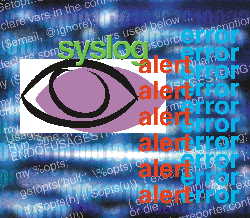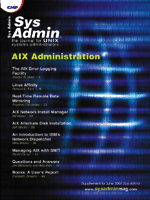 The
AIX Error Logging Facility The
AIX Error Logging Facility
Sandor W. Sklar
The primary goal of every UNIX systems administrator is to ensure
that the systems that they are responsible for are functioning smoothly
and with the best performance possible, 100% of the time. File systems
running out of space, applications dumping core, and Ethernet adapter
failures are just a sample of the types of things that can trip
up a system, impacting that goal. Therefore, it is critical that
the people responsible for a system are aware of anything that might
have an impact on attaining that 100% system availability.
One of the things that makes AIX my favorite flavor of UNIX is
that, besides all the standard tools, daemons, and configuration
files that are present in all flavors of UNIX, IBM has provided
a number of enhancements that make the monitoring, reliability,
and administration of RS/6000 systems second to none. This article
will focus on one of those tools: the error logging facility. I'll
show you how the AIX error logging facility works, then I'll
present a program I wrote that checks the log for error messages,
filters out any error messages you wish to ignore, and sends an
email to the systems administrator.
The Error Logging Subsystem
On most UNIX systems, information and errors from system events
and processes are managed by the syslog daemon (syslogd);
depending on settings in the configuration file /etc/syslog.conf,
messages are passed from the operating system, daemons, and applications
to the console, to log files, or to nowhere at all. AIX includes
the syslog daemon, and it is used in the same way that other
UNIX-based operating systems use it. In addition to syslog,
though, AIX also contains another facility for the management of
hardware, operating system, and application messages and errors.
This facility, while simple in its operation, provides unique and
valuable insight into the health and happiness of an RS/6000 system.
The AIX error logging facility components are part of the bos.rte
and the bos.sysmgt.serv_aid packages, both of which are automatically
placed on the system as part of the base operating system installation.
Some of these components are shown in Table 1.
Unlike the syslog daemon, which performs no logging at
all in its default configuration as shipped, the error logging facility
requires no configuration before it can provide useful information
about the system. The errdemon is started during system initialization
and continuously monitors the special file /dev/error for
new entries sent by either the kernel or by applications. The label
of each new entry is checked against the contents of the Error Record
Template Repository, and if a match is found, additional information
about the system environment or hardware status is added, before
the entry is posted to the error log.
The actual file in which error entries are stored is configurable;
the default is /var/adm/ras/errlog. That file is in a binary
format and so should never be truncated or zeroed out manually.
The errlog file is a circular log, storing as many entries
as can fit within its defined size. A memory buffer is set by the
errdemon process, and newly arrived entries are put into
the buffer before they are written to the log to minimize the possibility
of a lost entry. The name and size of the error log file and the
size of the memory buffer may be viewed with the errdemon
command:
[aixhost:root:/] # /usr/lib/errdemon -l
Error Log Attributes
--------------------------------------------
Log File /var/adm/ras/errlog
Log Size 1048576 bytes
Memory Buffer Size 8192 bytes
The parameters displayed may be changed by running the errdemon
command with other flags, documented in the errdemon man page.
The default sizes and values have always been sufficient on our systems,
so I've never had reason to change them.
Due to use of a circular log file, it is not necessary (or even
possible) to rotate the error log. Without intervention, errors
will remain in the log indefinitely, or until the log fills up with
new entries. As shipped, however, the crontab for the root
user contains two entries that are executed daily, removing hardware
errors that are older than 90 days, and all other errors that are
older than 30 days.
0 11 * * * /usr/bin/errclear -d S,O 30
0 12 * * * /usr/bin/errclear -d H 90
These entries are commented out on my systems, as I prefer that older
errors are removed "naturally", when they are replaced by
newer entries.
Viewing Errors
Although a record of system errors is a good thing (as most sys
admins would agree), logs are useless without a way to read them.
Because the error log is stored in binary format, it can't
be viewed as logs from syslog and other applications are.
Fortunately, AIX provides the errpt command for reading the
log.
The errpt command supports a number of optional flags and
arguments, each designed to narrow the output to the desired amount.
The man page for the errpt command provides detailed usage;
Table 2 provides a short summary of the most useful arguments. (Note
that all date/time specifications used with the errpt command
are in the format of mmddHHMMyy, meaning "month", "day",
"hour", "minute", "year"; seconds
are not recorded in the error log, and are not specified with any
command.)
Each entry in the AIX error log can be classified in a number
of ways; the actual values are determined by the entry in the Error
Record Template Repository that corresponds with the entry label
as passed to the errdemon from the operating system or an
application process. This classification system provides a more
fine-grained method of prioritizing the severity of entries than
does the syslog method of using a facility and priority code.
Output from the errpt command may be confined to the types
of entries desired by using a combination of the flags in Table
2. Some examples are shown in Table 3.
Dissecting an Error Log Entry
Entries in the error log are formatted in a standard layout, defined
by their corresponding template. While different types of errors
will provide different information, all error log entries follow
a basic format. The one-line summary report (generated by the errpt
command without using the "-a" flag) contains the
fields shown in Table 4:
Here are several examples of error log entry summaries:
IDENTIFIER TIMESTAMP T C RESOURCE_NAME DESCRIPTION
D1A1AE6F 0223070601 I H rmt3 TAPE SIM/MIM RECORD
5DFED6F1 0220054301 I O SYSPFS UNABLE TO ALLOCATE SPACE
IN FILE SYSTEM
1581762B 0219162801 T H hdisk98 DISK OPERATION ERROR
And here is the full entry of the second error summary above:
LABEL: JFS_FS_FRAGMENTED
IDENTIFIER: 5DFED6F1
Date/Time: Tue Feb 20 05:43:35
Sequence Number: 146643
Machine Id: 00018294A400
Node Id: rescue
Class: O
Type: INFO
Resource Name: SYSPFS
Description
UNABLE TO ALLOCATE SPACE IN FILE SYSTEM
Probable Causes
FILE SYSTEM FREE SPACE FRAGMENTED
Recommended Actions
CONSOLIDATE FREE SPACE USING DEFRAGFS
UTILITY
Detail Data
MAJOR/MINOR DEVICE NUMBER
000A 0006
FILE SYSTEM DEVICE AND MOUNT POINT
/dev/hd9var, /var
Monitoring with errreporter
Most, if not all systems administrators have had to deal with
an "overload" of information. Multiple log files and process
outputs must be monitored constantly for signs of trouble or required
intervention. This problem is compounded when the administrator
is responsible for a number of systems. Various solutions exist,
including those built into the logging application (i.e., the use
of a loghost for syslog messages), and free third-party solutions
to monitor log files and send alerts when something interesting
appears. One such tool that we rely on is "swatch", developed
and maintained by Todd Atkins. Swatch excels at monitoring log files
for lines that match specific regular expressions, and taking action
for each matched entry, such as sending an email or running a command.
For all of the power of swatch, though, I was unable to set up
the configuration to perform a specific task: monitoring entries
in the AIX error log, ignoring certain specified identifiers, and
emailing the full version of the entry to a specified address, with
an informative subject line. So, I wrote my own simple program that
performs the task I desired. errreporter (Listing 1) is a
Perl script runs the errpt command in concurrent mode, checks
new entries against a list of identifiers to be ignored, crafts
a subject line based upon several fields in the entry, and emails
the entire entry to a specified address.
errreporter can be run from the command line, though I
have chosen to have it run automatically at system startup, with
the following entry in /etc/inittab (all on a single line,
but broken here, for convenience):
errrptr:2:respawn:/usr/sec/bin/errreporter \
-f /usr/sec/etc/errreporter.conf /dev/console 2&1
Of course, if you choose to use this script, be sure to set the proper
locations in your inittab entry. The system must have Perl
installed; Perl is included with AIX as of version 4.3.3, and is available
in source and compiled forms from numerous Web sites. It relies only
on modules that are included with the base Perl distribution (see
Listing 2 for errreporter.conf file).
Although this script perfectly suits my current needs, there are
many areas in which it could be expanded upon or improved. For instance,
it may be useful to have entries mailed to different addresses,
based upon the entry's identifier. Another useful feature would
be to incorporate "loghost"-like functionality, so that
a program running on a single server can receive error log entries
sent by other systems, communicating via sockets à la the
syslog "@loghost" method.
Summary
The AIX Error Logging Facility can provide insight into the workings
of your system that are not available on other UNIX platforms. I
find it to be just one of the many advantages of AIX in a production
environment, and I hope that I have helped to explain this simple
yet powerful tool.
In this article, I have touched on some of the more commonly used
aspects of the Error Logging Facility in AIX. There are numerous
other features and capabilities of this subsystem, including the
use of the "diag" command for error log analysis
and problem determination, the addition of custom error templates,
the redirection of error log entries to and from the syslog
daemon, and the use of error notification routines in user-developed
code to provide notice and error logging to this subsystem. For
more information on those topics, and more detail on the items discussed
above, please see the documents listed in the References section
below.
References
The first source to go to for information on the usage of the
commands and programs that are part of the Error Logging Facility
is the man pages for the errpt, errdemon, errclear,
errinstall, errupdate, errlogger, and errdemon
commands, and for the errlog subroutine.
The complete listing of the entries in the Error Template Repository
can be generated with the "errpt -t" command, for
the one-line summary, or the "errpt -at" command,
for the full text of each error template.
A more in-depth overview of the Error Logging Facility can be
found in Chapter 10 of the AIX 4.3 Problem Solving Guide and
Reference, available online at:
http://www.rs6000.ibm.com/doc_link/en_US/a_doc_lib/aixprob/prbslvgd/errlogfac.htm
Sandor Sklar is a UNIX systems administrator at Standford University.
He can be reached at: [email protected].
| 
